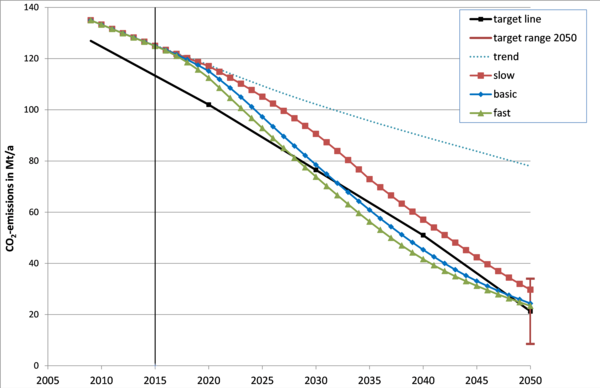DE Germany - Scenario Results and Monitoring Approaches
National Contact Point
Information in German language: National Contact Point Germany
National Residential Building Stock in Germany
|
Download Report on National Case Study Germany |
Download EPI Tables National Case Study Germany <PDF version> |
Last updated: 30.05.2016
Scope
| Scale | No. of dwellings | No. of buildings | No. of inhabitants | m² reference area |
|---|---|---|---|---|
| National | ~ 39 million | ~ 18 million | ~ 76 million (total population in Germany) |
~ 3,5 million (living space) |
Remarks and sources:
No. of dwellings, buildings and reference area refer to the residential building stock only (excluding dwellings in non-residential buildings; building stock in May 2011, residential buildings erected until end of 2009), Source: "Basisdaten für Hochrechnungen mit der Deutschen Gebäudetypologie des IWU", Institut Wohnen und Umwelt, Darmstadt, October 2013,
see Statistics of the German Building Stock;
No. of inhabitants refers to the total population in Germany (end of 2012, including inhabitants living in non-residential buildings), Source: Statistisches Bundesamt
Description of the action
According to the energy concept of the German Government a cross-sectoral reduction of greenhouse gas emissions will have to be achieved by 40 % until 2020 and by 80 % until 2050 (based on 1990). Moreover, there are specific aims for the building sector, inter alia a doubling of the energy refurbishment rate and the implementation of a climate-neutral level (NZEB) of new buildings by 2020.
During the EPISCOPE project possible paths on how to attain these targets in the national residential building stock were determined. The scenario analyses were based on an energy balance model of the German residential building stock which had been developed in the framework of the TABULA project. It was further build upon analyses which were already carried out in a national project (“Zielerreichungsszenario”) - dealing with scenarios until 2020 and a “snapshot”-analysis of the year 2050). In the EPISCOPE project scenarios of the whole period until 2050 were developed.
The main question to be answered by the scenarios was: How fast must improvement of thermal protection and introduction of new heating systems (away from oil and gas boilers to heat pumps, cogeneration, biomass and solar systems) take place in the building stock so that it will be early enough to reach the targets? Accordingly, trend and scenario calculations were carried out assuming different periods of time which are needed to accelerate the modernisation rates and introduce the new heating technologies in the renovation process (scenarios “fast”: 5 years, “basic”: 10 years, “slow”: 20 years).
Altogether it can be concluded that within the next 10 years (until 2025) continuous progress should be made to achieve a doubling of the annual rates of thermal building modernisation and a completely changed structure of the new installed heating systems. In addition also the structure of district heating and electric power generation (used for heat supply e.g. by heat pumps) will play an important role to reach the long-term climate protection targets. In both sectors a continuous change towards a share of more than 50 % of renewable energy will be necessary until 2050.
Also a concept for the regular monitoring of the achieved progress of thermal protection and heat supply measures in the German residential building stock was presented. In Germany this information cannot be collected from existing data sources so that new regular surveys will be necessary. To attain reliable results for the annual rates of thermal building modernisation (which are roughly speaking in the magnitude of 1 % per year) at least a sample of about 10,000 residential buildings should be considered.
 |
Links
Energy concept of the German Government from 2010:
http://www.bundesregierung.de/ContentArchiv/DE/Archiv17/_Anlagen/2012/02/energiekonzept-final.html;jsessionid=31965FB4E6540FCABD90B5279805A08B.s3t1?nn=437032
TABULA model of the German residential building stock:
http://episcope.eu/fileadmin/tabula/public/docs/report/TABULA_TR2_D8_NationalEnergyBalances.pdf
Scenario analyses in a national project (Zielerreichungsszenario):
http://www.iwu.de/forschung/energie/laufend/zielerreichungsszenario/
Last updated: 19.10.2015
| Responsible for the content of this page: IWU - Institute for Housing and Environment (contact information) |















